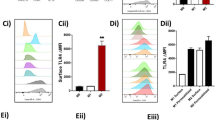Abstract
The lipopolysaccharide (LPS) of Gram negative bacteria is a well-known inducer of the innate immune response1. Toll-like receptor (TLR) 4 and myeloid differentiation factor 2 (MD-2) form a heterodimer that recognizes a common ‘pattern’ in structurally diverse LPS molecules. To understand the ligand specificity and receptor activation mechanism of the TLR4–MD-2–LPS complex we determined its crystal structure. LPS binding induced the formation of an m-shaped receptor multimer composed of two copies of the TLR4–MD-2–LPS complex arranged symmetrically. LPS interacts with a large hydrophobic pocket in MD-2 and directly bridges the two components of the multimer. Five of the six lipid chains of LPS are buried deep inside the pocket and the remaining chain is exposed to the surface of MD-2, forming a hydrophobic interaction with the conserved phenylalanines of TLR4. The F126 loop of MD-2 undergoes localized structural change and supports this core hydrophobic interface by making hydrophilic interactions with TLR4. Comparison with the structures of tetra-acylated antagonists bound to MD-2 indicates that two other lipid chains in LPS displace the phosphorylated glucosamine backbone by ∼5 Å towards the solvent area2,3. This structural shift allows phosphate groups of LPS to contribute to receptor multimerization by forming ionic interactions with a cluster of positively charged residues in TLR4 and MD-2. The TLR4–MD-2–LPS structure illustrates the remarkable versatility of the ligand recognition mechanisms employed by the TLR family4,5, which is essential for defence against diverse microbial infection.
This is a preview of subscription content, access via your institution
Access options
Subscribe to this journal
Receive 51 print issues and online access
$199.00 per year
only $3.90 per issue
Buy this article
- Purchase on Springer Link
- Instant access to full article PDF
Prices may be subject to local taxes which are calculated during checkout




Similar content being viewed by others
Accession codes
Primary accessions
Protein Data Bank
Data deposits
Atomic coordinates and the structure factor files have been deposited in the Protein Data Bank (http://www.rcsb.org) under accession number 3FXI.
References
Beutler, B. & Rietschel, E. T. Innate immune sensing and its roots: the story of endotoxin. Nature Rev. Immunol. 3, 169–176 (2003)
Kim, H. M. et al. Crystal structure of the TLR4–MD-2 complex with bound endotoxin antagonist Eritoran. Cell 130, 906–917 (2007)
Ohto, U., Fukase, K., Miyake, K. & Satow, Y. Crystal structures of human MD-2 and its complex with antiendotoxic lipid IVa. Science 316, 1632–1634 (2007)
Jin, M. S. et al. Crystal structure of the TLR1–TLR2 heterodimer induced by binding of a tri-acylated lipopeptide. Cell 130, 1071–1082 (2007)
Liu, L. et al. Structural basis of toll-like receptor 3 signaling with double-stranded RNA. Science 320, 379–381 (2008)
Raetz, C. R. Biochemistry of endotoxins. Annu. Rev. Biochem. 59, 129–170 (1990)
Raetz, C. R. & Whitfield, C. Lipopolysaccharide endotoxins. Annu. Rev. Biochem. 71, 635–700 (2002)
Medzhitov, R., Preston-Hurlburt, P. & Janeway, C. A. A human homologue of the Drosophila Toll protein signals activation of adaptive immunity. Nature 388, 394–397 (1997)
Shimazu, R. et al. MD-2, a molecule that confers lipopolysaccharide responsiveness on Toll-like receptor 4. J. Exp. Med. 189, 1777–1782 (1999)
Matsushima, N. et al. Comparative sequence analysis of leucine-rich repeats (LRRs) within vertebrate toll-like receptors. BMC Genom. 8, 124 (2007)
Bell, J. K. et al. The molecular structure of the Toll-like receptor 3 ligand-binding domain. Proc. Natl Acad. Sci. USA 102, 10976–10980 (2005)
Choe, J., Kelker, M. S. & Wilson, I. A. Crystal structure of human toll-like receptor 3 (TLR3) ectodomain. Science 309, 581–585 (2005)
Miyake, K. Roles for accessory molecules in microbial recognition by Toll-like receptors. J. Endotoxin Res. 12, 195–204 (2006)
Erridge, C., Bennett-Guerrero, E. & Poxton, I. R. Structure and function of lipopolysaccharides. Microbes Infect. 4, 837–851 (2002)
Rietschel, E. T. et al. Bacterial endotoxin: molecular relationships of structure to activity and function. FASEB J. 8, 217–225 (1994)
Bella, J., Hindle, K. L., McEwan, P. A. & Lovell, S. C. The leucine-rich repeat structure. Cell. Mol. Life Sci. 65, 2307–2333 (2008)
Galanos, C. et al. Synthetic and natural Escherichia coli free lipid A express identical endotoxic activities. Eur. J. Biochem. 148, 1–5 (1985)
Kobayashi, M. et al. Regulatory roles for MD-2 and TLR4 in ligand-induced receptor clustering. J. Immunol. 176, 6211–6218 (2006)
Kawasaki, K., Nogawa, H. & Nishijima, M. Identification of mouse MD-2 residues important for forming the cell surface TLR4–MD-2 complex recognized by anti-TLR4–MD-2 antibodies, and for conferring LPS and taxol responsiveness on mouse TLR4 by alanine-scanning mutagenesis. J. Immunol. 170, 413–420 (2003)
Re, F. & Strominger, J. L. Separate functional domains of human MD-2 mediate Toll-like receptor 4-binding and lipopolysaccharide responsiveness. J. Immunol. 171, 5272–5276 (2003)
Visintin, A., Latz, E., Monks, B. G., Espevik, T. & Golenbock, D. T. Lysines 128 and 132 enable lipopolysaccharide binding to MD-2, leading to Toll-like receptor-4 aggregation and signal transduction. J. Biol. Chem. 278, 48313–48320 (2003)
Teghanemt, A. et al. Novel roles in human MD-2 of phenylalanines 121 and 126 and tyrosine 131 in activation of Toll-like receptor 4 by endotoxin. J. Biol. Chem. 283, 1257–1266 (2008)
Jin, M. S. & Lee, J. O. Structures of the Toll-like receptor family and its ligand complexes. Immunity 29, 182–191 (2008)
Rietschel, E. T. et al. The chemical structure of bacterial endotoxin in relation to bioactivity. Immunobiology 187, 169–190 (1993)
Teghanemt, A., Zhang, D., Levis, E. N., Weiss, J. P. & Gioannini, T. L. Molecular basis of reduced potency of underacylated endotoxins. J. Immunol. 175, 4669–4676 (2005)
Rossignol, D. P. & Lynn, M. TLR4 antagonists for endotoxemia and beyond. Curr. Opin. Investig. Drugs 6, 496–502 (2005)
Mata-Haro, V. et al. The vaccine adjuvant monophosphoryl lipid A as a TRIF-biased agonist of TLR4. Science 316, 1628–1632 (2007)
Ulmer, A. J. et al. Biological activity of synthetic phosphonooxyethyl analogs of lipid A and lipid A partial structures. Infect. Immun. 60, 3309–3314 (1992)
Walsh, C. et al. Elucidation of the MD-2/TLR4 interface required for signaling by lipid IVa. J. Immunol. 181, 1245–1254 (2008)
McCoy, A. J., Grosse-Kunstleve, R. W., Storoni, L. C. & Read, R. J. Likelihood-enhanced fast translation functions. Acta Crystallogr. D 61, 458–464 (2005)
Kabsch, W. Automatic processing of rotation diffraction data from crystals of initially unknown symmetry and cell constants. J. Appl. Cryst. 26, 795–800 (1993)
Brünger, A. T. et al. Crystallography & NMR system: a new software suite for macromolecular structure determination. Acta Crystallogr. D 54, 905–921 (1998)
Jones, T. A., Zou, J. Y., Cowan, S. W. & Kjeldgaard, M. Improved methods for building protein models in electron density maps and the location of errors in these models. Acta Crystallogr. A 47, 110–119 (1991)
Lovell, S. C. et al. Structure validation by Cα geometry: φ, ψ and Cβ deviation. Proteins 50, 437–450 (2003)
Acknowledgements
We thank the staff of beamline 4A at the Pohang Accelerator Laboratory and beamline ID23-2 at ESRF for help with data collection. We thank J. Gross for critical reading of the manuscript. J.-O.L and co-workers are funded by the Creative Research Initiative (Center for Membrane Receptor Research) from the Ministry of Education, Science and Technology of Korea.
Author Contributions B.S.P., D.H.S. and H.M.K. performed the experiments. B.S.P. and J.-O.L. designed the experiments and analysed the data. B.S.P., H.L. and J.-O.L. wrote the paper. J.-O.L. managed the project and had overall responsibility for data interpretation and writing the manuscript. All authors discussed and commented on the manuscript.
Author information
Authors and Affiliations
Corresponding author
Supplementary information
Supplementary Information
This file contains a Supplementary Discussion, Supplementary Figures 1-11 with Legends, Supplementary Tables 1-2 and Supplementary References (PDF 3855 kb)
Rights and permissions
About this article
Cite this article
Park, B., Song, D., Kim, H. et al. The structural basis of lipopolysaccharide recognition by the TLR4–MD-2 complex. Nature 458, 1191–1195 (2009). https://doi.org/10.1038/nature07830
Received:
Accepted:
Published:
Issue Date:
DOI: https://doi.org/10.1038/nature07830
This article is cited by
-
Study on the mechanism of action of Wu Mei Pill in inhibiting rheumatoid arthritis through TLR4-NF-κB pathway
Journal of Orthopaedic Surgery and Research (2024)
-
Identification and prioritisation of potential vaccine candidates using subtractive proteomics and designing of a multi-epitope vaccine against Wuchereria bancrofti
Scientific Reports (2024)
-
The Emerging Role of Toll-Like Receptor-Mediated Neuroinflammatory Signals in Psychiatric Disorders and Acquired Epilepsy
Molecular Neurobiology (2024)
-
Role of toll-like receptor in the pathogenesis of oral cancer
Cell Biochemistry and Biophysics (2024)
-
Low-dose Lipopolysaccharide Alleviates Spinal Cord Injury-induced Neuronal Inflammation by Inhibiting microRNA-429-mediated Suppression of PI3K/AKT/Nrf2 Signaling
Molecular Neurobiology (2024)
Comments
By submitting a comment you agree to abide by our Terms and Community Guidelines. If you find something abusive or that does not comply with our terms or guidelines please flag it as inappropriate.



